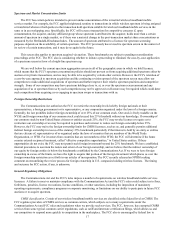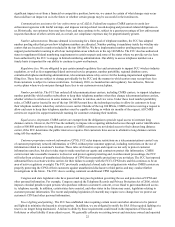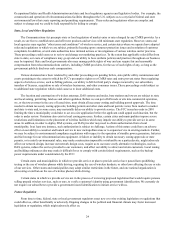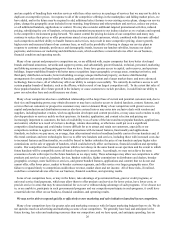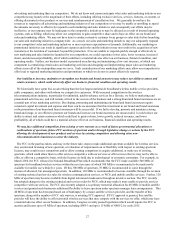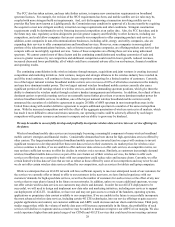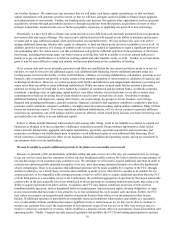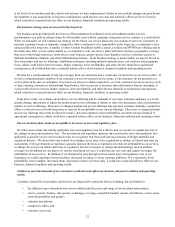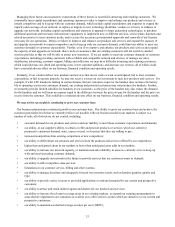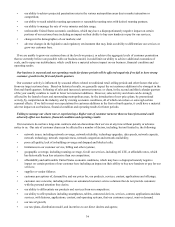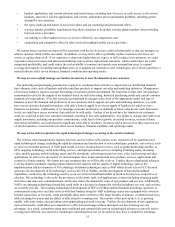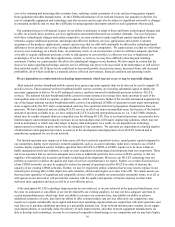Metro PCS 2011 Annual Report Download - page 37
Download and view the complete annual report
Please find page 37 of the 2011 Metro PCS annual report below. You can navigate through the pages in the report by either clicking on the pages listed below, or by using the keyword search tool below to find specific information within the annual report.26
and are capable of bundling their wireless services with these other services in a package of services that we may not be able to
duplicate at competitive prices. In response to all of the competitive offerings in the marketplace and falling market prices, we
have added, and in the future may be required to add, additional select features to our existing service plans, change our service
plans, change the geographic areas included in our roaming, long-distance and other products and services, reduce our prices,
or sell additional handsets, applications or content. We may also consider additional targeted promotional activities, reduced
pricing, subsidizing the cost of handsets, or increasing commission payments to our indirect dealers as we evaluate and respond
to the competitive environment going forward. We cannot control the pricing decisions of our competitors and many may
continue to reduce their prices or offer promotions aimed at our potential customers, which, combined with discounts afforded
such competitors and their ability to bundle features and services, may result in more competitive pricing, slower growth,
higher costs and increased churn of our customer base, as well as the possibility of having to change our service plans in
response to customer demands, preferences and demographic trends, increase our handset subsidies, increase our dealer
payments, and increase our marketing and distribution costs, which could have a material adverse effect on our business,
financial condition and operating results.
Many of our current and prospective competitors are, or are affiliated with, major companies that have better developed
brands and brand awareness, networks and support systems, and substantially greater financial, technical, personnel, marketing
and lobbying resources and bargaining power than we have. Some have greater access to capital, cash reserves, and spectrum
holdings; longer-established brands with better name recognition; larger geographic coverage areas, roaming territories, and
third-party distribution networks; better in-building coverage; unique intellectual property; exclusive distributorship
arrangements for certain popular brands of handsets, applications and content and a larger market share; and more advanced
technology than we have, all of which may affect our ability to compete successfully. We currently do not have access to sell
certain popular brands of handsets, such as the iPhone, which several of our largest competitors sell. To the extent that sales of
these popular handsets drive future growth in the industry or cause customers to switch providers, it could limit our ability to
grow our subscriber base and could increase our churn.
Many of our competitors also have established relationships with a larger base of current and potential customers and, due to
their size and bargaining power, may obtain discounts or may have exclusive access to desired handsets, content, features, and
services that our customers or prospective customers may want or demand. Many of our competitors with greater access to
capital and production and distribution resources also have entered into or may enter into exclusive deals with vendors and
suppliers, including handset vendors, wireless application developers and content providers, or may cause such vendors to only
develop products or services usable on their spectrum. As handset, application, and content selection and pricing are
increasingly important to customers, the lack of availability to us of some of the latest and most popular handsets, applications,
and content, whether as a result of exclusive dealings, volume discounting, or otherwise could put us at a significant
competitive disadvantage and could make it more difficult for us to attract and retain our customers, especially as our
competitors continue to aggressively offer handset promotions with increased features, functionality and applications.
Similarly, we believe we pay more, on average, than other national wireless broadband mobile carriers for our handsets and, if
this trend continues and new technologies force us to offer new handsets and services, including those with increased costs due
to increased features and functionality, we could be forced to further subsidize the price of our handsets and pay higher sales
commissions on the sale or upgrade of handsets, which could adversely affect our business, financial condition and operating
results. Our competitors have licensed spectrum which is not always in the same bands as our spectrum and the extent to which
future handsets will be compatible across all bands of spectrum is uncertain. Accordingly, we may not achieve the same
economies of scale with respect to the future handsets as we enjoy today. These advantages may allow our competitors to offer
products and services (such as, handsets, devices, handset subsidies, higher commissions to distributors and dealers, broader
geographic coverage, more facilities or services, and greater bundled features, applications and content) that we do not and
cannot offer, offer lower prices, market to broader customer segments, and offer service over larger geographic areas. Our
failure to respond timely to competition could reduce revenue, market share and net income. All of these risks, if realized,
could have a material adverse effect on our business, financial condition, and operating results.
Some of our competitors have, or may in the future, take advantage of governmental loan, grant or credit programs, or
universal service fund payments, which may allow them to offer products and services for lower prices, have lower costs, or
provide service in areas that may be uneconomical for us to serve without taking advantage of such programs. If we choose not
to, or are unable to, participate in such governmental programs and our competitors participate in such programs, it could have
a material adverse effect on our business, financial condition, and operating results.
We may not be able to respond quickly or effectively to new marketing and sales initiatives launched by our competitors.
Many of our competitors have far greater sales and marketing resources with far larger marketing budgets than we do. We do
not spend as much on advertising and marketing as some of our competitors. We generally have had, and anticipate in the
future having, less sales and marketing resources than our competitors, and we have spent, and anticipate spending, less on



